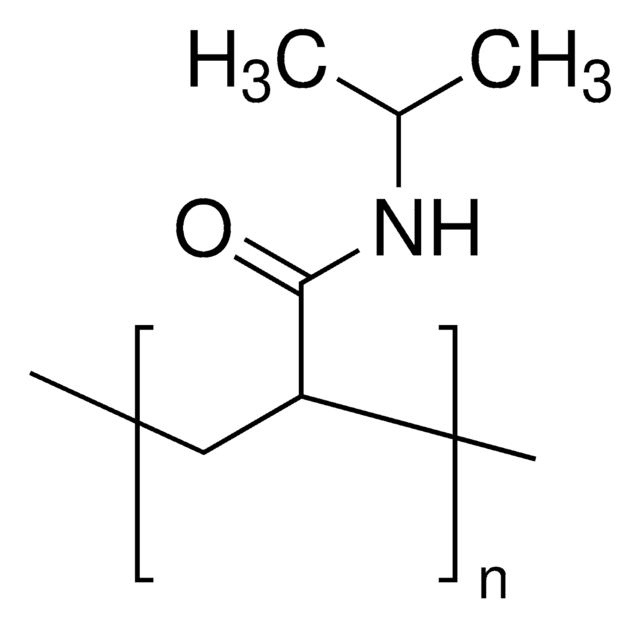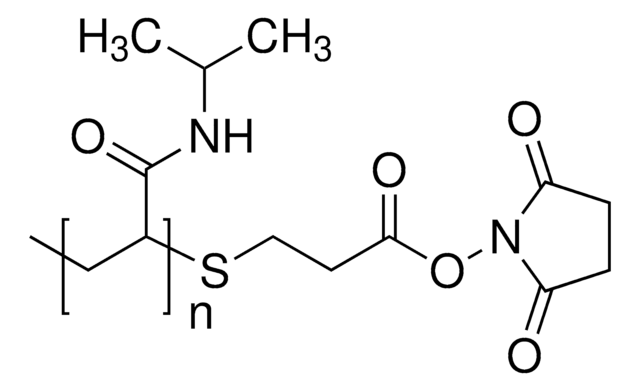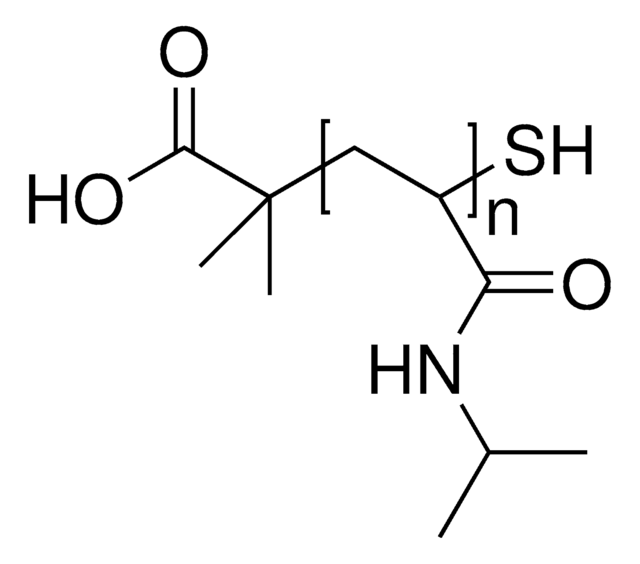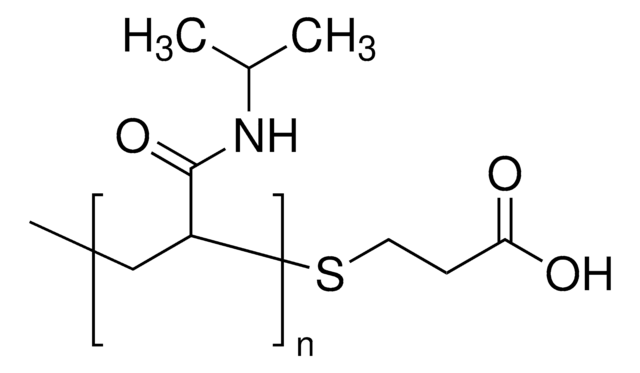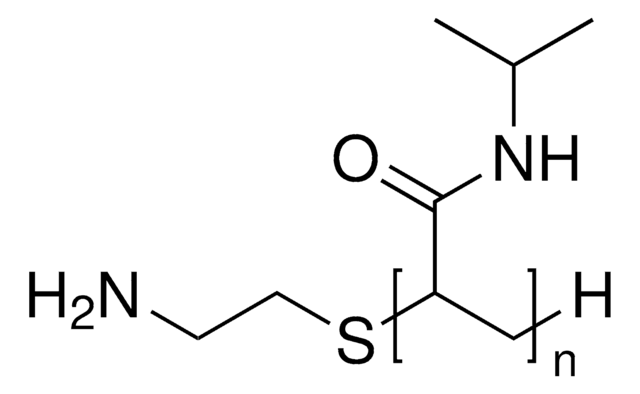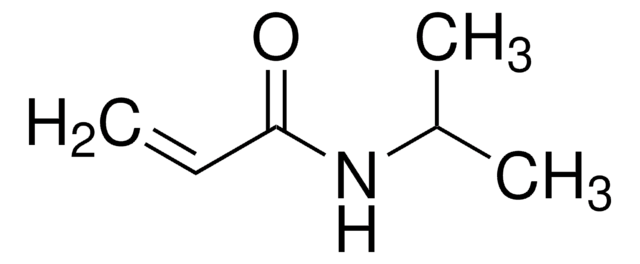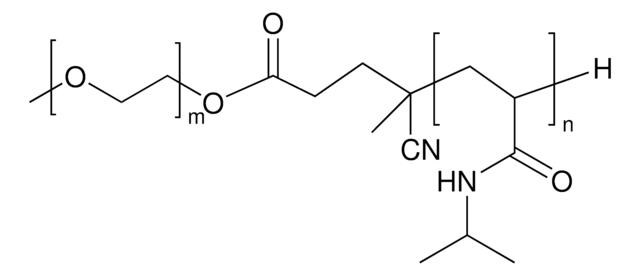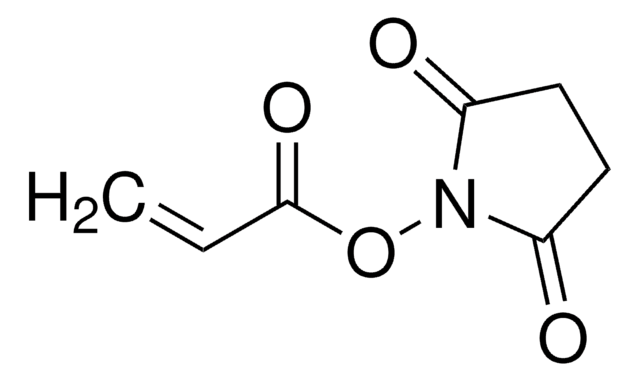900188
Poly(N-isopropyl acrylamide)
NHS ester end functionalized, average Mn 5,000
Sinônimo(s):
PNIPAM, polyNIPAM
Faça loginpara ver os preços organizacionais e de contrato
About This Item
Fórmula linear:
C8H10NO4(C6H11NO)nH
Código UNSPSC:
12162002
NACRES:
NA.23
Produtos recomendados
Aplicação
Poly(N-isopropyl acrylamide) (PolyNIPAM) is a stimuli-responsive polymer. This product features low polydispersity (PDI), which typically leads to better reproducibility in applications, and a terminal N-hydroxysuccinimide (NHS) functional group, allowing for rapid conjugation of biomolecules, small molecules, or other polymers. PolyNIPAM has been used in development of a variety of thermosensitive coated micro/nano materials, including thermoresponsive polymeric drug delivery systems.
Código de classe de armazenamento
11 - Combustible Solids
Classe de risco de água (WGK)
WGK 3
Ponto de fulgor (°F)
Not applicable
Ponto de fulgor (°C)
Not applicable
Escolha uma das versões mais recentes:
Certificados de análise (COA)
Lot/Batch Number
Lamentamos, não temos COA para este produto disponíveis online no momento.
Se precisar de ajuda, entre em contato Atendimento ao cliente
Já possui este produto?
Encontre a documentação dos produtos que você adquiriu recentemente na biblioteca de documentos.
Aniket S Wadajkar et al.
Acta biomaterialia, 8(8), 2996-3004 (2012-05-09)
New magnetic-based core-shell particles (MBCSPs) were developed to target skin cancer cells while delivering chemotherapeutic drugs in a controlled fashion. MBCSPs consist of a thermo-responsive shell of poly(N-isopropylacrylamide-acrylamide-allylamine) and a core of poly(lactic-co-glycolic acid) (PLGA) embedded with magnetite nanoparticles. To
Chenglin Yi et al.
Journal of colloid and interface science, 380(1), 90-98 (2012-05-29)
Self-assembled polymeric micelles can be used as efficient particulate emulsifiers. To explore the relationship between micellar structure and emulsification performance, pH- and temperature-responsive self-assembled micelles were prepared and used as emulsifiers, based on a novel grafted polymer poly(styrene-alt-maleic acid)-graft-poly(N-isopropyl acrylamide)
Manuel Pernia Leal et al.
ACS nano, 6(12), 10535-10545 (2012-11-03)
We report a procedure to grow thermo-responsive polymer shells at the surface of magnetic nanocarriers made of multiple iron oxide superparamagnetic nanoparticles embedded in poly(maleic anhydride-alt-1-ocatadecene) polymer nanobeads. Depending on the comonomers and on their relative composition, tunable phase transition
William S Turner et al.
Journal of biomedical materials research. Part B, Applied biomaterials, 100(8), 2060-2072 (2012-08-14)
The packaging and delivery of cells for cardiac regeneration has been explored using a variety biomaterials and delivery methods, but these studies often ignore one or more important design factors critical for rebuilding cardiac tissue. These include the biomaterial architecture
Yan Xia et al.
Chemical communications (Cambridge, England), 49(25), 2566-2568 (2013-02-21)
Site-specific protein conjugates with RAFT polymers were synthesized using expressed protein ligation. Stable micelles were formed from both linear block copolymer and Y-shaped conjugates.
Artigos
Professor Mitsuhiro Ebara provides insights on several types of smart nanofiber mesh systems that have been explored for different drug delivery purposes.
Nossa equipe de cientistas tem experiência em todas as áreas de pesquisa, incluindo Life Sciences, ciência de materiais, síntese química, cromatografia, química analítica e muitas outras.
Entre em contato com a assistência técnica